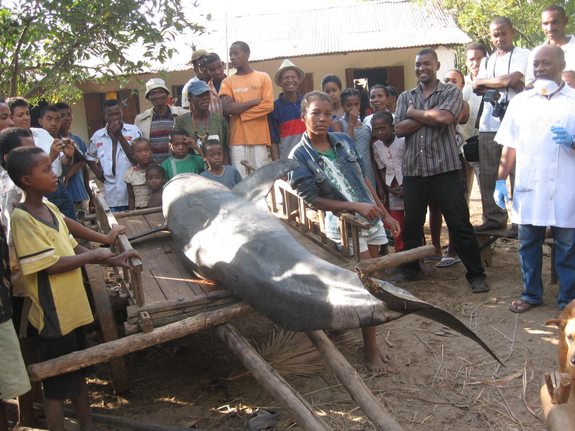Sonar Blamed for Mass Stranding of Melon-Headed Whales

Four years ago, about 100 melon-headed whales mysteriously entered a shallow lagoon system in northwest Madagascar and became stranded. Now scientists say the creatures' demise was likely brought on by sonar used to map the ocean floor for ExxonMobil. Previous research has suggested that sonar can be harmful to marine mammals.
The underwater noise can mask the calls of dolphins and whales and scare them away from their feeding grounds. Naval exercises using sonar have been linked to a 2008 stranding of at least 60 dolphins along the coast of Cornwall, England.
But researchers say the new findings from Madagascar mark the first time a marine mammal mass stranding has been closely tied to high-frequency sonar mapping. [Whale Album: Giants of the Deep] From May to June 2008, about 100 melon-headed whales (Peponocephala electra) swam into Madagascar's shallow, tidal Loza Lagoon system, a highly unusually environment for the toothed whales, which usually stick to the open ocean.
An independent review panel made up of five scientists considered a wide range of possible explanations for the mass stranding, including disease, toxins, vessel strikes, storm conditions and unusual acoustic events.
The panel wrote in their newly published report that on May 29, 2008, a day before the first stranding occurred, a survey vessel contracted by ExxonMobil Exploration and Production (Northern Madagascar) had been using a high-power 12 kHz multi-beam echosounder system to map the ocean floor about 40 miles (65 kilometers) offshore.
Multibeam sonars send out sound waves in a fan shape beneath a ship's hull to produce a map of the seafloor. The 12 kHz sonar emitted by the survey vessel is within the frequency of best hearing sensitivity for melon-headed whales, the panel wrote. But these sounds at the 120-decibel level would be well above the hearing threshold the whales.
The scientists concluded that the sonar mapping was the most "plausible and likely behavioral trigger for the animals initially entering the lagoon system."
"Implications go well beyond the hydrocarbon industry, as these sonar systems are widely used aboard military and research vessels for generating more precise bathymetry (underwater mapping)," Howard Rosenbaum, director of the Ocean Giants program for the Wildlife Conservation Society, said in a statement.
"We now hope that these results will be used by industry, regulatory authorities, and others to minimize risks and to better protect marine life, especially marine mammal species that are particularly sensitive to increasing ocean noise from human activities," Rosenbaum said.
ExxonMobil, meanwhile, disputed the findings. "ExxonMobil believes the panel's finding about the multi-beam echo sounder is unjustified due to the lack of certainty of information and observations recorded during the response efforts in 2008," Patrick McGinn, a spokesman for the .
Category:

..png)








0 comments:
Post a Comment